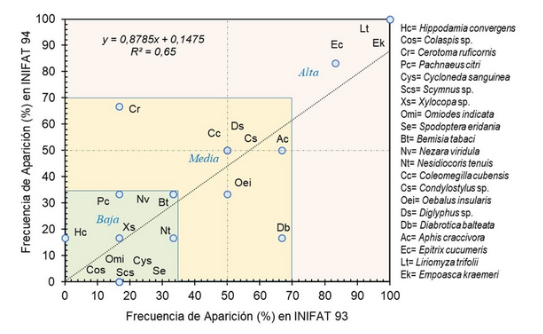Insects associated with cowpea in agroecosystems of Pinar del Río, Cuba
Main Article Content
Abstract
This study aimed to determine the species of insects associated with cowpea (Vigna unguculata (L.) Walp.) in agroecosystems of Pinar del Río, Cuba. Samplings were carried out during the vegetative and reproductive phases of the cultivars 'INIFAT 93' and 'INIFAT 94'. The frequency of appearance in the two cultivars was determined, as well as their relationship by means of linear regression. The classification criteria of Mason and Bryant were also followed. There were 21 insect species, including phytophagous (61.9%) and beneficial (38.1%), grouped into 14 families and five orders, with the highest representation of Coleoptera and Hemiptera. The families with the highest species richness were Chrysomelidae and Coccinelidae., Of the identified species, 71.4% were observed on the two cowpea bean cultivars. A frequency of occurrence greater than 50% was shown by Empoasca kraemeri Ross & Moore, Liriomyza trifolii Burgess in Comstock, Epitrix cucumeris (Harris), Aphis craccivora Koch, Coleomegilla cubensis (Casey), Condylostylus sp., and Diglyphus sp.
Article Details

This work is licensed under a Creative Commons Attribution-NonCommercial 4.0 International License.
Aquellos autores/as que tengan publicaciones con esta revista, aceptan los términos siguientes:
- Los autores/as conservarán sus derechos de autor y garantizarán a la revista el derecho de primera publicación de su obra, el cual estará simultáneamente sujeto a la Licencia Creative Commons Attribution-NonCommercial 4.0 International (CC BY-NC 4.0) que permite a terceros compartir la obra, siempre que se indique su autor y la primera publicación en esta revista. Bajo esta licencia el autor será libre de:
- Compartir — copiar y redistribuir el material en cualquier medio o formato
- Adaptar — remezclar, transformar y crear a partir del material
- El licenciador no puede revocar estas libertades mientras cumpla con los términos de la licencia
Bajo las siguientes condiciones:
- Reconocimiento — Debe reconocer adecuadamente la autoría, proporcionar un enlace a la licencia e indicar si se han realizado cambios. Puede hacerlo de cualquier manera razonable, pero no de una manera que sugiera que tiene el apoyo del licenciador o lo recibe por el uso que hace.
- NoComercial — No puede utilizar el material para una finalidad comercial.
- No hay restricciones adicionales — No puede aplicar términos legales o medidas tecnológicas que legalmente restrinjan realizar aquello que la licencia permite.
- Los autores/as podrán adoptar otros acuerdos de licencia no exclusiva de distribución de la versión de la obra publicada (p. ej.: depositarla en un archivo telemático institucional o publicarla en un volumen monográfico) siempre que se indique la publicación inicial en esta revista.
- Se permite y recomienda a los autores/as difundir su obra a través de Internet (p. ej.: en archivos telemáticos institucionales o en su página web) antes y durante el proceso de envío, lo cual puede producir intercambios interesantes y aumentar las citas de la obra publicada. (Véase El efecto del acceso abierto).
References
Boukar O, Belko N, Chamarthi S, Togola A, Batieno J, Owusu E, et al. Cowpea (Vigna unguiculata): Genetics, genomics and breeding. Plant Breed. 2019;138(4):415–24. DOI: 10.1111/pbr.12589
Farooq M, Rehman A, Al-Alawi A, Al-Busaidi W, Lee D-J. Integrated use of seed priming and biochar improves salt tolerance in cowpea. Scientia Horticulturae. 2020;272:109507. DOI: 10.1016/j.scienta.2020.109507
Quintero E, Gil V, García J, Rodríguez G. Potencialidades del caupí para la rápida compensación de pérdidas de la producción de frijol por desastres naturales. Centro Agrícola. 2010;37(3):5–9.
Figueroa Y, Ventura Martín J de la C, Rodríguez Morales S, Arredondo Quevedo I, Albert Llerena J, Gálvez Guerra J, et al. Caracterización de tres nuevas variedades de Vigna unguiculata (“IPA 206”, “IPA 207” y ’GUARIBA’) en Cuba. Centro Agrícola. 2014;41(2):65–9.
Carrillo C. Manual de plagas del cultivo de fríjol caupi [Internet]. Perú: Universidad Nacional de Tumbes; 2015 [cited 2022 Mar 7]. Available from: http://rgdoi.net/10.13140/RG.2.1.3971.3121
Ramírez R, Romero Nápoles J, Vera Graziano J, Equihua Martínez A, Bautista Martínez N, Hernández Morales J, et al. Demografía de brúquidos (Coleoptera: Bruchidae) asociados. AZM. 2017;33(1). DOI: 10.21829/azm.2017.3311007
Kébé K, Alvarez N, Espíndola A. Oviposition choice and larval development of the seed beetle Callosobruchus maculatus (F.) (Coleoptera: Chrysomelidae: Bruchinae) on three cowpea varieties. Journal of Stored Products Research. 2020;86:101578. DOI: 10.1016/j.jspr.2020.101578
Garima G, Khan R, Seal D. Cowpea weevil, Callosobruchus maculatus (Insecta: Coleoptera: Bruchidae): EENY-769/IN1338. EDIS. 2021;2021(5). DOI: 10.32473/edis-in1338-2021
Hernández A, Pérez J, Bosch D, Castro N. Clasificación de los suelos de Cuba 2015. Mayabeque, Cuba: Ediciones INCA; 2015.
Díaz M. Avance de las investigaciones en el cultivo de frijol carita. In: 90 años de la Estación Agronómica de Santiago de las Vegas. La Habana, Cuba: Editorial Academia; 1994.
Marrero L, Tejera Y, Liriano R, Torres L, Fernández R, Rojas M, et al. Insectos nocivos asociados al cultivo del garbanzo (Cicer arietinum L.) en zonas de la provincia Matanzas. Rev Protección Veg [Internet]. 2016 [cited 2022 Dec 26];31(2):134–6. Available from: http://scielo.sld.cu/scielo.php?script=sci_arttext&pid=S1010-27522016000200008&lng=es
Pérez J, Suris M, Torres A. Comportamiento de insectos asociados al cultivo del garbanzo en áreas agrícolas de Las Tunas, Cuba. Ojeando la agenda [Internet]. 2018 [cited 2022 Dec 26];(54). Available from: https://dialnet.unirioja.es/servlet/articulo?codigo=6639415
Crop Protection Compendium. Wallingford, Reino Unido: CAB International; 2007. ISBN>: 9781845933579.
Vázquez L, Matienzo Y, Veitía M, Alonso J. Conservación y manejo de enemigos naturales de insectos fitófagos en los sistemas agrícolas de Cuba. Cuba: Editorial CIDISAV; 2008. 198 pp.
Mason C, Bryant R. The structure and diversity of the animal communities in a broadland reedswamp. Journal of Zoology. 1974;172(3):289–302. DOI: 10.1111/j.1469-7998.1974.tb04106.x
González D, Álvarez Hernández U, Lima Orozco R. Insectos plagas asociados al cultivo intercalado caupí-sorgo según sus fases fenológicas. Centro Agrícola. 2016;43(4):5–13.
Liu X, Qi M, Xu H, Wu Z, Hu L, Yang M, et al. Nine Mitochondrial Genomes of the Pyraloidea and Their Phylogenetic Implications (Lepidoptera). Insects. 2021;12(11):1039. DOI: 10.3390/insects12111039
Mendoza Betancourt E, Vargas Batis B, Plana Quiala A, Ramos García Y. Diversidad de insectos benéficos asociada a la flora existente en fincas suburbanas en Santiago de Cuba, Cuba. RCHE. 2021;47(1):121–45. DOI: 10.35249/rche.47.1.21.13
